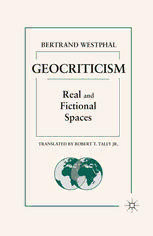
Geocriticism: Real and Fictional Spaces PDF
Preview Geocriticism: Real and Fictional Spaces
Geocriticism ALSO BY BERTRAND WESTPHAL Le monde plausible. Espace, lieu, carte Austro- fictions. Une géographie de l’intime L’œil de la Méditerranée. Une odyssée littéraire Roman et Évangile Littérature et espaces (with Juliette Vion- Drury and Jean- Marie Grassin) La géocritique mode d’emploi (editor) Geocriticism Real and Fictional Spaces Bertrand Westphal Translated by Robert T. Tally Jr. geocriticism Copyright © Les Éditions de Minuit, 2007. English translation copyright © 2011 by Robert T. Tally Jr. Softcover reprint of the hardcover 1st edition 2007 978-0-230-11021-2 All rights reserved. First published in France as La Géocritique: Réel, Fiction, Espace by Les Éditions de Minuit First published in English in 2011 by PALGRAVE MACMILLAN® in the United States—a division of St. Martin’s Press LLC, 175 Fifth Avenue, New York, NY 10010. Where this book is distributed in the United Kingdom, Europe, and the rest of the world, this is by Palgrave Macmillan, a division of Macmillan Publishers Limited, registered in England, company number 785998, of Houndmills, Basingstoke, Hampshire RG21 6XS. Palgrave Macmillan is the global academic imprint of the above companies and has companies and representatives throughout the world. Palgrave® and Macmillan® are registered trademarks in the United States, the United Kingdom, Europe and other countries. ISBN 978-1-349-29257-8 ISBN 978-0-230-11916-1 (eBook) DOI 10.1057/9780230119161 Library of Congress Cataloging- in-P ublication Data Westphal, Bertrand. [Géocritique. English] Geocriticism : real and fictional spaces / Bertrand Westphal ; translated by Robert T. Tally Jr. p. cm. Originally published in French as La géocritique: réel, fiction, espace. 1. Space in literature. 2. Geography in literature. 3. Geographical perception in literature. 4. Geography and literature. 5. Geocriticism. 6. Literature, Modern— History and criticism— Theory, etc. I. Tally, Robert T. II. Title. PN56.S667W4713 2011 809'.9332— dc22 2010043637 Design by Scribe Inc. First edition: May 2011 10 9 8 7 6 5 4 3 2 1 Transferred to Digital Printing in 2013 À Titti Contents Translator’s Preface: The Timely Emergence of Geocriticism ix Introduction 1 1 Spatiotemporality 9 2 Transgressivity 37 3 Referentiality 75 4 Elements of Geocriticism 111 5 Reading Spaces 149 Notes 171 Index 187 TRANSLATOR’S PREFACE The Timely Emergence of Geocriticism In recent years, space—a long with such related concepts or practices as spatial- ity, mapping, topography, deterritorialization, and so forth—h as become a key term for literary and cultural studies. The nineteenth century had been domi- nated by a discourse of time, history, and teleological development (following in the Hegelian tradition) and by a modernist aesthetic that enshrined the tem- poral, especially with respect to individual psychology (à la Marcel Proust’s In Search of Lost Time). But after the Second World War, space began to reassert itself in critical theory, rivaling if not overtaking time. The “spatial turn”1 was aided by a new aesthetic sensibility that came to be understood as postmodern- ism, with a strong theoretical critique provided by poststructuralism, especially in French philosophy, but quickly extending into various countries and dis- ciplines. Moreover, the transformational effects of postcolonialism, globaliza- tion, and the rise of ever more advanced information technologies helped to push space into the foreground, as traditional spatial or geographic limits were blurred, erased, or redrawn. In this context, critics and theorists had to develop novel interpretive and critical models to address what Fredric Jameson, referring specifically to Edward Soja’s illuminating study, has called the “new spatiality implicit in the postmodern.”2 In the churning wake of the postmodern condi- tion— or perhaps, now, post- postmodern condition— we are understandably interested in making, reading, and revising our maps. Space is, well, timely. Thus, it is also timely that Bertrand Westphal’s Geocriticism: Real and Fic- tional Spaces appears (now in English). Westphal, who directs the research team devoted to “Espaces Humains et Interactions Culturelles” at the Université de Limoges, has long advocated a “geocentered” approach to literature and cultural studies, which would allow a particular place to serve as the focal point for a variety of critical practices. Thus, Westphal’s edited collection on the Mediter- ranean3 looked at the various depictions of that multifaceted zone— whether
